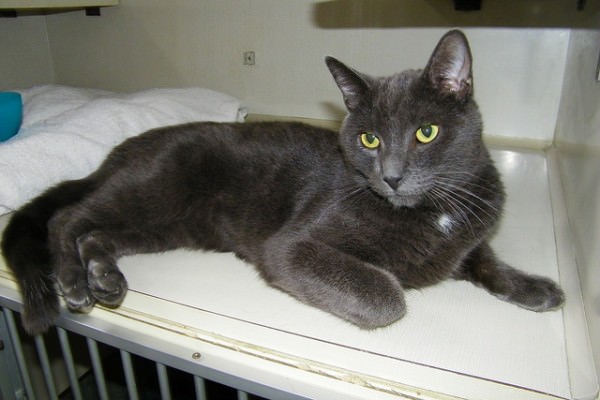Once you’ve made the choice to do a great deed for society by adopting from a shelter or rescue, there are a few things to consider so that you can pick out the perfect cat for you. Before you make that fateful trip to the shelter/rescue, spend some time thinking about these key factors and implement them when choosing your new cat:
 Source: Corey Seeman via Flickr
Source: Corey Seeman via Flickr
1. Carefully Consider Your Home Environment
If you live alone, with no other pets in the home, then you’ll have more options available to you when selecting your rescue cat. These poor cats have already had it tough enough after being abandoned or surrendered, so you’ll want to do the right thing and be sure that you are bringing them into an environment where they can be at peace. If you have kids in the home or other pets, especially dogs, be sure that you find a cat that will do well in a busy home like yours. It’s only fair to consider their needs if you want to build a strong bond with your new cat right from the start. Small kids might not know how to properly handle a young kitten, and mature cats will make great additions as they have patience and aren’t as fragile.
 Source: Mr.TinDC via Flickr
Source: Mr.TinDC via Flickr
2. Think of Your Work Schedule
When you are selecting the right kitty to make as your forever feline companion, choose a cat that can acclimate well with your schedule. If you work long hours, or frequently spend a lot of time away from your home, you won’t want to choose a breed of cat that doesn’t do well alone for extended periods of time. This wouldn’t be fair to a cat breed that has specific needs and is known for needing more companionship with their humans. Some breeds that strongly prefer companionship are: Abyssinians, Burmese, Bengals, and the Siamese.
**It’s also important to note that every cat is an individual, and this is just a generalized example.

3. Find a Cat That Responds Well To You
Some cats may have certain fears due to previous bad experiences in their life. You’ll want to find a cat that responds well to your touch and doesn’t feel overly intimidated by you. If you’re really wanting a lap cat with a constant need to be near you, then try and find a cat that likes being cuddled and enjoys spending time being held. The way a cat acts around you says a lot, and if they are drawn to you then this is a very good sign. Some cats are more shy then others, while others aren’t too big on the idea of being held. Be patient, because the right cat for you is out there. It might not happen at your first visit to the shelter/rescue.
 Source: hehaden via Flickr
Source: hehaden via Flickr
4. Observe All the Cats Before You Make Your Final Selection
All cats are beautiful, and you want to make sure that you give every cat there a fair chance before making your final selection. When you arrive, take a slow walk-through of all the cats that are available for adoption, surveying each carefully. Choosing a cat is a permanent decision and you want to be thorough in your selection before ending your search. And just as the saying goes, “sometimes the best is saved for last.” The most perfect cat for you could be the very last one that you happen to see, and you’ll never know unless you take the opportunity to do a solid walk-through.
 Source: Kurt Faler via Flickr
Source: Kurt Faler via Flickr
5. Spend Quality Bonding Time with Your Chosen Cat/Kitten
The way a cat behaves behind the safety of a private enclosure may be quite different than the way that they act when giving the opportunity to roam free with you in a confined space. Once you’ve chosen the cat that interests you the most, be sure to spend time with them in the designated area that the shelter/rescue has for hands-on, secluded visitation.
 Source: hehaden via Flickr
Source: hehaden via Flickr
6. During Visitation, See Your Potential Cat’s Reaction To Petting and Handling
Although a cat may seem perfectly fine inside their kennel, once in your arms it could be a completely different story. When petting your potential cat, see how they react to soft petting. When gently handling the cat if they try to swat or bite, growing impatient quickly, this is not the best choice for either you or the cat if you have small children in your home. If you do have kids, have them join you when you visit the shelter to see how the cat reacts to them as well. This is especially important if these kids are going to live in the home with the cat on a full-time basis.
 Source: Corey Seeman via Flickr
Source: Corey Seeman via Flickr
7. Be Smart and Ask as Many Questions as You Can
If your potential cat could talk, they would want tell you all they could about their life and what they’ve endured. Sadly, this is not the case, for obvious reasons. Feel free to ask the workers at the facility anything and everything about the cat that you’re interested in so this way you can learn as much about them as possible. Also, be sure to read their “Cat Bio” carefully because many of the questions you may have can be answered right there. For example: cat’s temperament towards other animals, shyness, how they adapt to new environments, etc. You’ll also want to be sure to check your cat’s health report which could list possible allergies, previous surgeries, or anything else on their health history that the facility might know.
